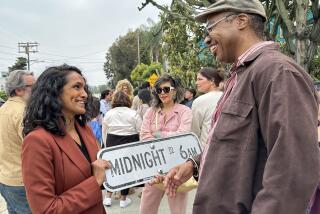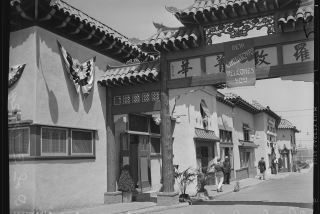Rebirth of Signal Hill
In Signal Hill, size counts. Being a 2.2-square-mile island surrounded by a much larger city has left the oil town without an identity.
Enter the ZIP Code as civic soul.
Until now, the small city with big dreams has shared three ZIP Codes with parts of Long Beach, which dwarfs it with 49 times more people and big-city problems like higher crime.
That has cost the working-class community higher insurance premiums, mistaken utility charges and lost mail--even caused grocery chains to stay away. City Hall has struggled to collect its full share of sales tax from the state, which sometimes gives it instead to Long Beach.
More profound than mail snags, residents said in a city survey, the lack of a ZIP Code has robbed Signal Hill of a sense of place.
“The first thing you get,” said longtime Signal Hill Police Capt. Mary Risinger, “is, ‘Where the hell is Signal Hill?’ If they know it, they say, ‘Oh, isn’t that the city where the black football player died?’ ”
The city’s 12-year effort to get its own five-digit mail address will culminate when results of a federally mandated postal survey of Signal Hill mail customers are announced next week.
Signal Hill’s is the story of ZIP Code power, not for a Beverly Hills but for a humble oil town of 9,330 residents. “The little city,” said Mayor Larry Forester, “that could and did.”
Striking change has occurred in the city, once made famous as America’s richest oil field and later made notorious by the 1981 jail death of a college athlete.
The case of Ron Settles tainted the town’s image for years, and may still tarnish it, particularly among African Americans, who comprise 13% of its population. The remainder, according to the 2000 census: white, 45%; Hispanic, 26%; and Asian, 16%.
The Cal State Long Beach football player was arrested by Signal Hill police for speeding and booked into the city jail. He was later found hanged in his cell.
Police insisted that Settles committed suicide. But his family, represented by attorney Johnnie L. Cochran Jr., won a $760,000 wrongful death settlement.
Afterward, police commanders left the department and a new chief cleaned house, Risinger and other officers said.
Still, a reputation lingers among some outsiders that Signal Hill is mostly oil tanks, roughnecks and rednecks.
Yet startling change is impossible to miss, and not just the African American city councilman who has served as mayor.
A $1-million estate, other pricey hilltop homes and a Mercedes-Benz dealership are being built. Signal Hill is among California’s top 10 cities for highest per capita sales tax revenue--considered the civic cash cow--thanks to its thriving auto row, Costco and Home Depot.
Hundreds of Wells Still Produce Oil
That Signal Hill lacks strong identity is curious considering its past. It incorporated in 1924.
Three years earlier, in 1921, the first oil gusher drew 15,000 spectators in a day. The gleeful discovery would turn Los Angeles County into the world’s fifth-largest oil producer. Of about 3,000 wells in Signal Hill, about 600 remain and continue to produce oil.
Today, Signal Hill remains remarkable, but for different reasons.
Three of its five City Council members are openly gay, although homosexual rights was not a campaign issue.
That makes Signal Hill one of only three small cities in America with majority gay city councils, according to the Advocate, a gay-oriented publication. West Hollywood and Wilton Manors, Fla., are the others.
Signal Hill may have the only U.S. mayor known to have AIDS. Diagnosed with HIV in 1985 and AIDS in 1994, Forester, a retired engineer who often worked with ocean oil platforms, ran for office with the aim of shepherding hilltop development.
“It always irritates me when someone brings up the few negative things in the past,” the New York transplant said with a sigh.
“Yes, they happened, but there is so much else. My guess is that the city is 20% gay, and clearly if you look at the council, things have changed. If this isn’t a tolerant place, where is?”
The prospect of its own ZIP Code arrives just as Signal Hill seems on the verge of coming into its own--to the surprise of many.
Ranata and Allen Ralston moved in November from coastal Long Beach to a trilevel townhouse on the hill. Though smaller, the home has spectacular ocean views from every room and seems custom designed to display their substantial art collection.
“When I told my bridge group we were moving to Signal Hill,” said Ranata Ralston, Santa Catalina Island visible out a bedroom window, “They said, ‘Why would you move from the water to the ghetto?’ ”
She smiles and admits that she initially had to persuade her husband to consider moving inland.
“People just don’t know how it’s changed,” she said of Signal Hill. “I think it’s still kind of a secret.”
Geography Hinders Struggle for Identity
For decades, Signal Hill’s struggle for an independent identity has been straitjacketed by geography. How the community came to be surrounded by Long Beach is, as with most things Signal Hill, the result of its black gold.
Hundreds of years before drilling began, the slope was populated by Native Americans, who sent smoke signals from its peak. Historical references note that even then, oil factored into daily life on the hill. The Indians used it to waterproof canoes.
Commercial oil drilling changed the community, which had depended on sheep, cattle and flower farming.
Long Beach began collecting a barrel tax on the oil. When oil company executives sought relief from the state, they were told that incorporation was the only way to dodge the tax. And so in 1924, Signal Hill became a city. The woman who led the cityhood drive, Jessie Nelson, became the first mayor. Local historians say she was California’s first female mayor.
A grab for remaining oil drilling rights ensued between the cities, creating Signal Hill’s jigsaw shape.
The town has never had the proverbial Main Street, a downtown anchor. Into that void sprouted world-famous Curley’s Cafe, which opened in 1932 to serve oil roustabouts and construction workers.
Curley’s sits at the intersection of Signal Hill’s past and present.
Out in the parking lot, towering oil derricks ee-ah! loudly. Across this corner of Cherry Avenue at Willow Street are Costco and Home Depot. Opposite Curley’s is the new Food-4-Less and Starbucks.
The mood is small-town diner. If you want to see almost anyone in town, come here. A typical cast of customers one recent morning includes silver-haired oil men, younger cops, the mayor, the town historian, old-coot gadflies and newcomer contractors, in town to build the mansions.
Glancing at a mug covered by a rainbow, 77-year-old Robert Lee, an oilman from Shreveport, La., cracks a joke. “Oh,” he says with a wink, “you got the fruity cup.” The waitress chides him and says, “You’re surrounded by gay folks, so what’s the big deal?” Lee shrugs. “No big deal actually,” he says. “I’m just not one of ‘em. Don’t really matter to me.”
While gays may not be championed in every quarter, a live-and-let-live tolerance prevails, Forester said. He speculates that Signal Hill’s spectacular views have attracted gay residents. Also, he said, Signal Hill is close to Long Beach, which has at least 20 gay bars and a large gay population.
It is not that, but growth on the hill, gossip and ZIP Code gripes that pepper the diner’s din.
The city government expects it will get its ZIP Code. A 1997 city survey returned by 22% of Signal Hill mail customers showed 75% in favor. Results of the current federal postal survey, a mandatory assessment before any ZIP Code actions are taken, will be announced Jan. 15.
Those mail customers who oppose a changed ZIP Code point to the cost of replacing stationery, invoices and advertising. Many of the car dealerships already use Long Beach in their signs anyway because more people know where it is.
Signal Hill leaders have lobbied for the ZIP Code for 12 years. The U.S. Postal Service repeatedly denied the city’s plea, citing Signal Hill’s lack of a post office. Each ZIP Code requires one, said Long Beach Postmaster Ed Jenkins.
Much Resistance to New ZIP Code
The city offered property on which to build itself a post office. For a variety of reasons, those deals fell through. The powerful union representing the 600 mail carriers in the Long Beach area also resisted the ZIP Code change because it would disrupt so many routes in a complicated seniority system.
Given all that, it startled many involved when the U.S. postmaster general ordered the new Signal Hill postal survey last month.
U.S. Rep. Steve Horn (R-Long Beach), who had spent a decade fighting for the ZIP Code, met with the postmaster general for anthrax discussions and only in passing mentioned the Signal Hill matter.
Jenkins said the postmaster general decided that an existing mail distribution center could be used for Signal Hill’s mail--at least for the time being. The union and Jenkins believe a new facility costing up to $4 million may be required, but many details remain to be worked out.
“When a miracle happens,” City Manager Ken Farsing said, laughing, “You don’t ask why.”
More to Read
Sign up for Essential California
The most important California stories and recommendations in your inbox every morning.
You may occasionally receive promotional content from the Los Angeles Times.










